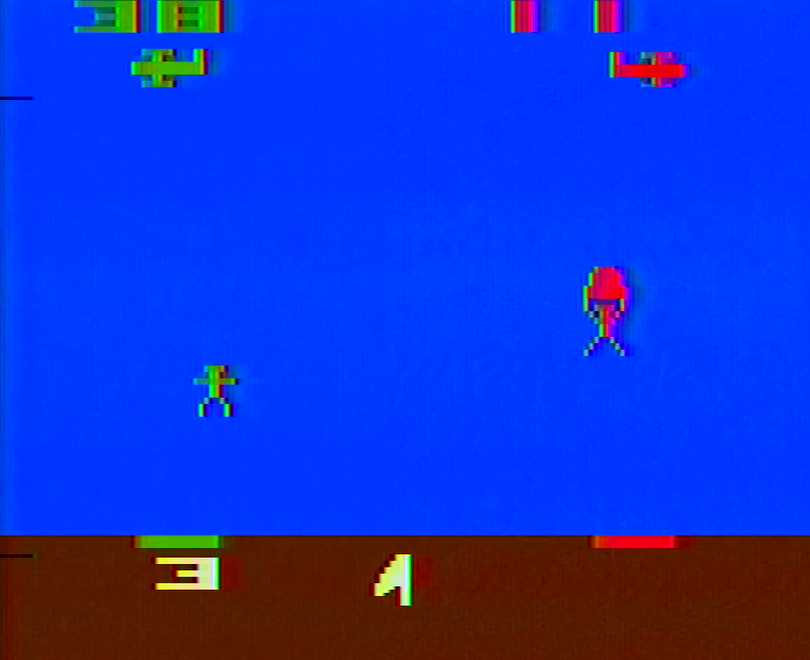
In writing about Human Cannonball, I mentioned how odd it was that it came out alongside another daredevil themed game. This short-lived experiment in theme synergy might be something that only could have still worked in this last gasp of the 1970s daredevil craze in the United States, but I can safely say that Sky Diver – released by Sears as Dare Diver – is a much stronger and funnier than its cannon-based counterpart. I would go so far as to say that it stands in the upper echelon of great multiplayer games on the VCS, and certainly it’s one of the stronger entries on any home console in its day.
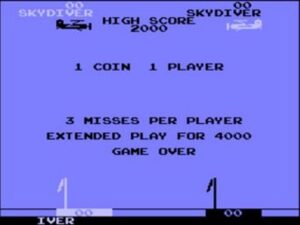
Sky Diver is by Jim Huether, responsible previously for the October 1978 release Flag Capture. Whereas Flag Capture was a bit rougher and more divisive in its reception, Sky Diver is a fast-paced, easily understood game that was, according to a 2007 interview with Huether, the best selling VCS game before 1980’s Space Invaders – though existing records provide very little to corroborate this, and contemporary news reporting frequently focuses instead on the 1978 releases Breakout and Basketball as hot games. Much like Human Cannonball, Sky Diver is based in part on Owen Rubin’s arcade Skydiver game, released in June 1978. According to an interview with historian Keith Smith, Rubin indicated that he had started straightaway on Skydiver after work ended on the unreleased Cannonball arcade game; the idea stemmed from the “splat” sound he had developed for that machine, though management initially didn’t like the idea of splattering the jumper on the ground. As such the early prototype of the game saw the targets floating on the water, and if the diver splashed in after missing the target, a speedboat would come and pick them up. Management then asked him to add the splat back in to make the game more humorous, Rubin said, so he had the artist Bob Flamante redraw some silly characters with wide open mouths and flailing limbs. If they splatted against the ground, the sprite would wind up with just the head and flailing legs sticking up, with an ambulance driving over to pick them up. Exidy ended up cloning Skydiver and debuting it at the AMOA 1978 show as Rip Cord, with the only real game play tweak being the addition of hostile helicopters who would shoot at your diver.
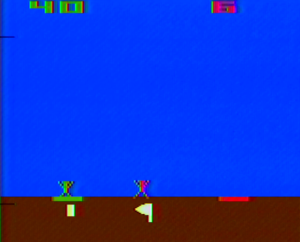
Huether notes he was already halfway through development of it before he realized there was an arcade version that he could see and play. In our interview, Huether explained that he picked up Sky Diver about two weeks after finishing Flag Capture. He said that a list of game concepts was being passed around, and he thought that sounded particularly interesting. Once he and Rubin had learned of the other’s efforts, they got together to share ideas.Coincidentally enough, the two had similar ideas for the sound effects used in game; much as Rubin had originally done to get the audio of the “splat” sound for his unreleased Cannonball game, Huether recalled using audio equipment to record him throwing wadded up, wet paper towels at the walls and floor. These sampled recordings were then tweaked and downscaled to the VCS’s capabilities and used to make most of the audio effects found in Sky Diver: the parachute opening, the splat sound, and the successful landing sound all stem from this effort. When Huether explained this to Rubin, he reportedly remarked that it was really similar to what he’d done.
Both the arcade and VCS games have similar concepts – two players leap out of planes, open their chutes, and try to land on a target while contending with the wind. In both games, you can also control your descent once your chute is open, though if the wind is too strong there’s little you can do to push back. After nine jump opportunities, the game ends. Huether explained that while he was working on his game unaware of the arcade game, there was still some convergent evolution happening: both of them had a pair of planes dropping divers onto landing targets, after all. But after meeting up with Rubin and seeing what the arcade game featured, Huether did tweak his VCS game to some degree to play more similarly to it, adding the wind sock and moving landing platforms.

There are some key differences between the two owing to those differences under the hood. In Rubin’s arcade game, the controls use a pair of large, steel D-rings that you needed to pull to open your chute. The lights behind the Skydiver marquee will also flash one at a time, and will stop when a player leaps out of the plane. Successfully landing will “earn” that letter below their score, and spelling out the game’s name will, depending on the machine’s settings, give you bonus points, an extra life, or a free game; Rubin was a big fan of pinball and insisted on this distinctly pinball-style feature, and Skydiver arcade is an extremely early example of that crossover between video games and electromechanical tech, revisited later in an all-digital form by Universal in arcade games like Mr. Do and Lady Bug with specific methods to earn a free game, pinball style.
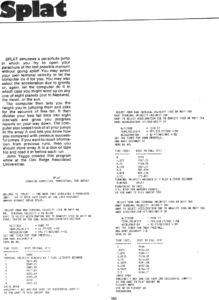
Beyond that, both the arcade game and the VCS version determines how many points a player earns on a successful landing by how long they’re in free fall before opening their chute. This is actually quite similar to an early text-based computer game called Splat, popularized through David Ahl’s 101 Basic Computer Games book. The idea there was to open your chute as late as possible without smashing into the ground to maximize points. Sky Diver takes that concept, adds graphics, and an actual target to hit. A key difference between the arcade and home versions of Sky Diver involve the actual chute deployment: in the arcade game, there’s a bit of a delay before your parachute fully deploys. If you open it too late, you won’t have time to get your chute open before hitting the ground and splatting. The home version just has the chute open pretty much as soon as you pull on the joystick. The arcade game also has a computer opponent that you can compete against if you don’t have a second player on hand, while the VCS Sky Diver is really a two-player specific affair. Finally, as a neat little secret, Rubin snuck his initials into the arcade game’s object graphics ROM, though there is no known way to actually see them in the game itself.
Huether said that the VCS was obviously a less powerful platform than custom arcade hardware, he couldn’t mimic all the aspects of Rubin’s game accurately. Thanks to the Atari house style of having multiple variations on a cart, however, he was able to provide a greater mix of Sky Diver rules that ultimately resulted in a more robust package than a straight port of the arcade game could have provided. The first two gametypes are similar to the arcade game, with respective landing pads for each player to try and touch down on. Game two has smaller pads than game one, but otherwise they’re the same, and both players can use the wind sock indicator to see exactly how strong the wind is blowing and how that might impact their leap and their chute deployment.

Games three and four remove the wind factor but replace it with moving landing pads. Like before, game four makes the pads smaller than game three but they are otherwise identical. These gametypes are tricky to find the right timing for your jumps, though without the wind you can eventually get a sense of when you should leap from your plane and when you can deploy your chute to catch the pad with some regularity. The final gametype brings back the wind and sees you playing chicken – there’s one landing pad in the middle of the screen that both players are trying to land on, but only the first player to successfully touch down gets points. The difficulty switches adjust how quickly your plane flies by in gametypes one through four; the switches do nothing in the chicken variant to avoid giving one player an advantage. This is probably the most entertaining option, since it allows you to directly screw over your opponent. All of these console-specific twists on the core game were things Huether said he’d already been working on before encountering Rubin’s arcade Skydiver, and they really help it to stand apart as its own unique title.
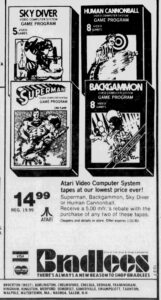
The result of all this is a game with enough variety to make it a blast to continually try and land your daredevils on their targets. And hey, if you miss, you get a disproportionately funny little animation and sound effect of your jumper plopping into the dirt with just their head and arms above ground. It really shouldn’t be as funny as it is, and yet every time it gets a chuckle out of me and anyone else I’ve played the game with. In all, not bad for six months of work for Huether.
For a game that Huether said sold well, however, Sky Diver seems to have largely gone overlooked in the press. Outside of mentions in advertisements, a 1980 rebate offer, and the occasional column as a game that is now available, Sky Diver flew under the radar. The only other mention I found was a blurb in Vidiot’s tongue-in-cheek summary of VCS games several years after its release. Looking to Atari Corporation’s sales records from the late 1980s, they reported selling about 11,000 copies of the game between 1986 and 1988, a relatively small number. This suggests that Sky Diver was more a flavor of the month – a simple game that just fell to the wayside as VCS games grew in complexity, though never quite so far to the wayside that it fell off the market until nearly a decade after its release. But that’s fine – whether or not it was a sales juggernaut in the 1980s, Sky Diver is still a really exciting game in short bursts with a second player. Definitely worth a look, even if only to mash your avatar into the earth a few times for laughs.
Sources:
Jim Huether, interview with the author, May 14 2023
Jim Huether, interview with Scott Stilphen, ataricompendium.com, 2007
Skydiver – 1977 Atari Inc., www.orubin.com
All in Color for a Quarter, Keith Smith, unpublished manuscript, 2016
Atari Corp. 2600 Sales figures, 1986-1990
Atari History Timelines, Michael Current
Cannonball – 1976 Atari Inc., Owen Rubin, https://arcarc.xmission.com/Web Archives/www.Orubin.com
Release date sources:
Sky Diver – Source: New York Daily News, March 22 1979; Philadelphia Inquirer, April 8 1979;
